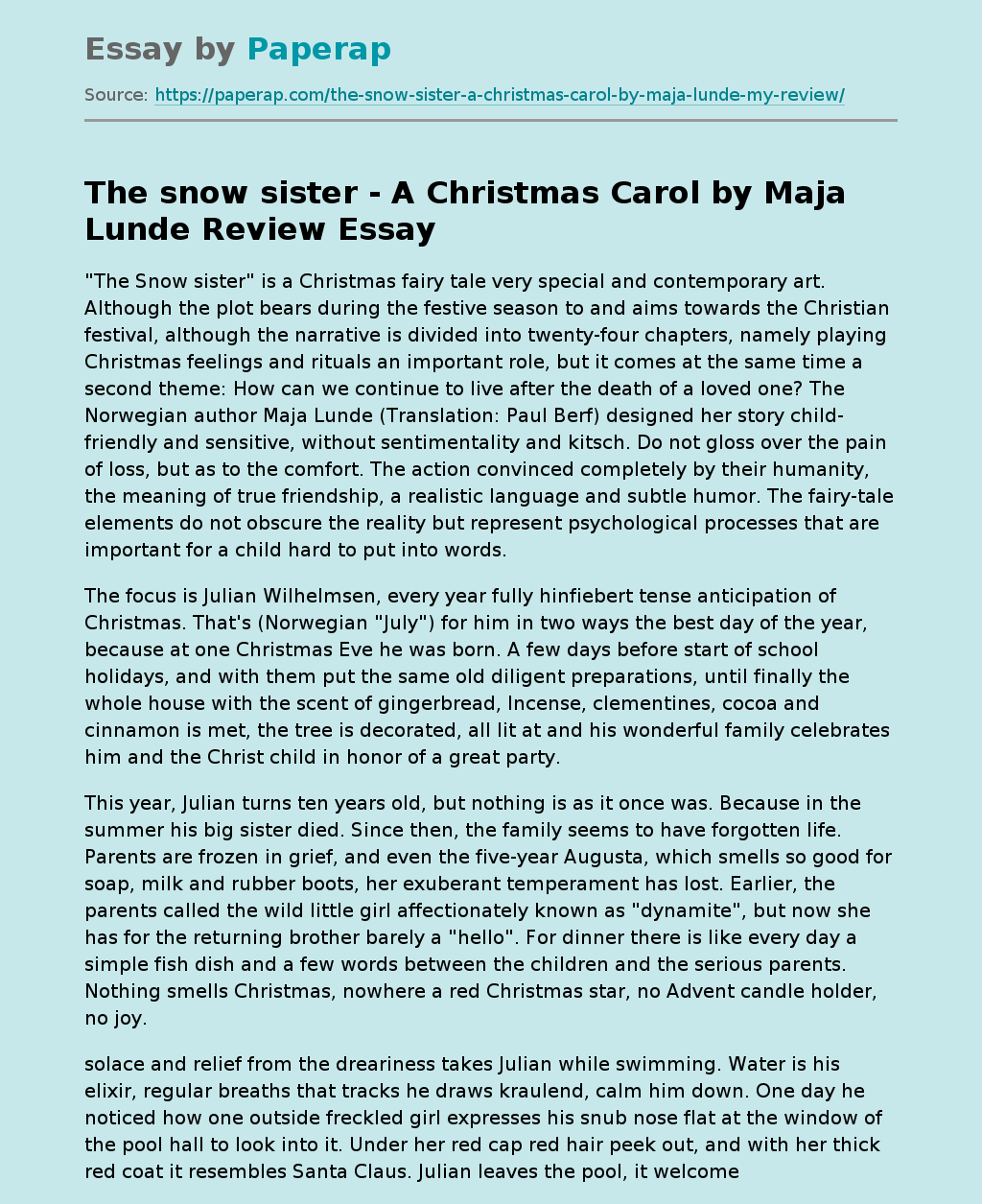“The Snow sister” is a Christmas fairy tale very special and contemporary art. Although the plot bears during the festive season to and aims towards the Christian festival, although the narrative is divided into twenty-four chapters, namely playing Christmas feelings and rituals an important role, but it comes at the same time a second theme: How can we continue to live after the death of a loved one? The Norwegian author Maja Lunde (Translation: Paul Berf) designed her story child-friendly and sensitive, without sentimentality and kitsch.
Do not gloss over the pain of loss, but as to the comfort. The action convinced completely by their humanity, the meaning of true friendship, a realistic language and subtle humor. The fairy-tale elements do not obscure the reality but represent psychological processes that are important for a child hard to put into words.
The focus is Julian Wilhelmsen, every year fully hinfiebert tense anticipation of Christmas. That’s (Norwegian “July”) for him in two ways the best day of the year, because at one Christmas Eve he was born.
A few days before start of school holidays, and with them put the same old diligent preparations, until finally the whole house with the scent of gingerbread, Incense, clementines, cocoa and cinnamon is met, the tree is decorated, all lit at and his wonderful family celebrates him and the Christ child in honor of a great party.
This year, Julian turns ten years old, but nothing is as it once was. Because in the summer his big sister died.
Since then, the family seems to have forgotten life. Parents are frozen in grief, and even the five-year Augusta, which smells so good for soap, milk and rubber boots, her exuberant temperament has lost. Earlier, the parents called the wild little girl affectionately known as “dynamite”, but now she has for the returning brother barely a “hello”. For dinner there is like every day a simple fish dish and a few words between the children and the serious parents. Nothing smells Christmas, nowhere a red Christmas star, no Advent candle holder, no joy.
solace and relief from the dreariness takes Julian while swimming. Water is his elixir, regular breaths that tracks he draws kraulend, calm him down. One day he noticed how one outside freckled girl expresses his snub nose flat at the window of the pool hall to look into it. Under her red cap red hair peek out, and with her thick red coat it resembles Santa Claus. Julian leaves the pool, it welcomes the unknown girl with strange familiarity, “There you are at last.”
Hedvig Hansen (so she imagines) proves to be a paragon of love of life. Continuously quasselnd it emits “light in the winter darkness” of the boy. Fascinated she is by his swimming arts that should fill him with great pride. however, you can not swim. to learn it was her “greatest heart’s desire in the universe.” Julian is sure that he can you easily fulfill this wish.
Julian forgets his dreary thoughts completely, takes along as Hedvig him into her home. The “Villa Mistletoe” is a Christmas wonderland where everything is decorated and shines as the Christmas Day would already dawned. But to this mysterious house, even to himself Hedvig entwines a serious secret that only explore the boy needs.
All of this leaves the Norwegian author Maja Lunde their sensitive, thoughtful protagonists tell itself. Each similarly assessed young readers will be affected precision of Julian’s observations of the grieving family and considerations to it ( “two copies that do not really know how my mother and my father were normally”) of its efforts to out of sadness rise ( “Think of something good”) and way back to the carefree gaiety of the Christmas season. In the end he manages to defeat the superior forces of sadness to strike a balance between mournful remembrance and joy of life
intellectual part young readers (from the earliest nine years) will be able to take this story -. As comfort and understanding help if they came already with the theme of death in the family in touch, as food for thought, if not. Tears will flow, but the vivid, unsentimental narrative style with greatly varying emotions, brisk dialogues, horror effects and mysterious magic it is dry again. Sadness is sent intercepted by Christmassy magic, the atmosphere of the snowy landscapes and bright starry sky, from the sincere harmony in the family and the careful use among friends.
My enthusiasm for this book is based to a large extent in its generous presentation that fully developed the effects described by Maja Lunde’s narrative. The afford in the first place the numerous vividly colored illustrations of Norwegian artist Lisa Aisato. Her expressive portraits, often of striking perspectives, some with a double side come to the point the moods of the characters, the essence of the scene depicted capture. Besides, the sides adorned lovingly depicted objects for winter and Christmas season, alongside those soulless mass products and fancy decorative items look cold. The detail of all illustrations rewarded intense viewing. Many pages of text are highlighted in color, the content mood matched by friendly light to dark menacing tones.
More Reviews beautiful: Books and music CDs for the Advent and Christmas time, see Books and music for the Advent and Christmas season on books reviews “/ a>.
Even the Beautiful cover in fine embossing and festive red, white and gold decor is eye catching. It is the Christmas aspect to the forefront and already characterized some of the main characters with their associated attributes, while the two protagonists in the central picture frame with a romantic winter forest straight run to the expectant observer.
The snow sister - A Christmas Carol by Maja Lunde Review. (2019, Nov 18). Retrieved from https://paperap.com/the-snow-sister-a-christmas-carol-by-maja-lunde-my-review/

